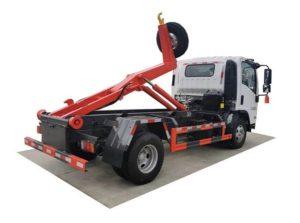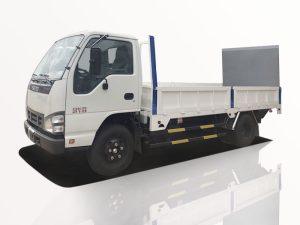Monday to Saturday - 8:00 -17:30
How Wide is a Flatbed Semi Trailer?
Flatbed semi trailers are essential vehicles in the transportation industry, widely utilized for their versatility and ability to carry various types of cargo. Understanding the width of flatbed semi trailers is crucial for logistics planning, compliance with regulations, and ensuring safe transport. In this article, we will thoroughly explore the dimensions, regulations, and practical tips related to flatbed semi trailers, offering insights for truckers, shippers, and industry enthusiasts alike.
What Is a Flatbed Semi Trailer?
A flatbed semi trailer is an open trailer without sides or a roof, designed to transport oversized and heavy loads. The flat platform allows for easy loading and unloading of cargo, making it an optimal choice for items like construction materials, machinery, and vehicles.
Types of Flatbed Semi Trailers
There are several types of flatbed semi trailers catering to various cargo types and transportation needs:
- Standard Flatbed: The most common type, ideal for general cargo.
- Step Deck or Drop Deck: Designed with a lower deck to accommodate taller loads.
- Extendable Flatbed: Can be extended to handle longer loads.
- Gooseneck Flatbed: Features a gooseneck hitch for better maneuverability and allows for additional load height.
Flatbed Semi Trailer Dimensions
Standard Width of Flatbed Semi Trailers
The standard width for flatbed semi trailers is typically 8.5 feet (102 inches). However, there are some variations:
| Type | Width (inches) |
|---|---|
| Standard Flatbed | 102 |
| Step Deck Flatbed | 102 |
| Gooseneck Flatbed | 102 |
| Extended Flatbed | Varies |
Height and Length Regulations
While width is a primary focus, height and length are also regulated. The maximum height for flatbed loads is usually 13.5 feet, while the maximum length can be up to 53 feet for semi trailers. These dimensions must be adhered to for safe and legal transportation on highways.
Weight Regulations for Flatbed Trailers
Understanding Weight Limits
The gross vehicle weight rating (GVWR) of a flatbed semi trailer is crucial for compliance. Most flatbed trailers have a GVWR ranging from 80,000 to 90,000 pounds, depending on the number of axles and configuration.
How Weight Affects Dimensions
Heavy loads may affect the stability and width allowance during transport. Always check local regulations to ensure compliance with weight and width restrictions.
Factors Affecting the Width of Flatbed Semi Trailers
Load Type
The type of cargo being transported can affect the width. Some commodities may require a wider loading space. Always secure cargo effectively to maintain stability.
Local Regulations
Different regions may have different regulations regarding width limits. Before transport, it’s essential to check local laws in the states or regions you will be traveling through.
Practical Examples of Flatbed Width Usage
Example 1: Construction Materials
A construction company often uses flatbed trailers to transport steel beams. Each load can be as wide as 8.5 feet, ensuring the beams are securely strapped and within legal limits.
Example 2: Heavy Machinery
Transporting heavy machinery like bulldozers may sometimes require special permits to exceed the standard width. This typically results in additional costs and planning for escorts during transport.
Loading and Unloading Tips for Flatbed Trailers
Best Practices for Safety
- Ensure the trailer is on level ground before loading and unloading.
- Use ramps for loading heavier items onto the trailer.
- Always secure loads with straps or chains to prevent movement during transit.
- Inspect the load regularly to confirm it remains stable.
Equipment Needed
Consider using specialized loading equipment like forklifts or cranes if the cargo is particularly heavy or awkwardly shaped. This ensures safety and reduces the risk of damage.
Flatbed Trailer Maintenance
Importance of Regular Maintenance
Regular maintenance is essential for keeping a flatbed semi trailer in optimal condition. This includes checking the following:
- Tires and brakes.
- Load straps and chains for wear and tear.
- Electrical systems for proper functioning.
- Trailer lights for visibility and safety.
Maintenance Tasks
Perform the following maintenance tasks regularly:
- Inspect tire pressure and tread.
- Lubricate moving parts.
- Check for signs of rust or corrosion.
- Test brake lights and turn signals.
FAQs about Flatbed Semi Trailer Width
1. What is the maximum width allowed for flatbed semi trailers?
The maximum width for standard flatbed semi trailers is typically 8.5 feet (102 inches) in the United States. Anything wider may require special permits.
2. Can a flatbed trailer exceed 102 inches in width?
Yes, a flatbed trailer can exceed this width but may require special permits, and the transport may need to adhere to specific regulations, including escort vehicles.
3. How do I determine if my load exceeds the flatbed width limits?
Measure the cargo width before loading and compare it to the maximum allowed width of your flatbed trailer. If it exceeds 8.5 feet, check local regulations.
4. Are there different widths for different types of flatbed trailers?
Most flatbed trailers share a standard width of 8.5 feet, but some custom or specialized trailers may vary based on their design and intended use.
5. What are the consequences of exceeding flatbed width limits?
Exceeding width limits without a permit can lead to fines, legal ramifications, and increased risk of accidents during transport. It is essential to adhere to all regulations.
6. Do weight and width regulations differ by state?
Yes, weight and width regulations can vary significantly from state to state. Always check with local transportation authorities before making long hauls across state lines.









